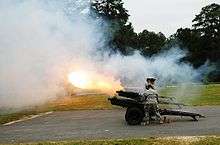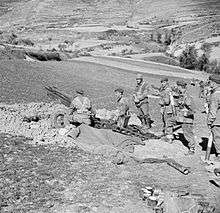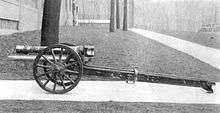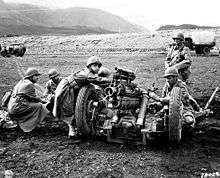M116 howitzer
| 75mm Pack Howitzer M1A1 on Carriage (airborne) M8 | |
|---|---|
|
Two M116 Howitzers, Chengkungling History Museum, Taiwan (2011) | |
| Type | Pack howitzer |
| Place of origin |
|
| Service history | |
| In service | 1927–present |
| Used by |
United States, United Kingdom, France, the Philippines, Republic of China, Turkey, People's Republic of China, Viet Minh, Pakistan Yugoslavia |
| Wars |
World War II, Second Sino-Japanese War, Korean War, Chinese Civil War, First Indochina War, Vietnam War, Kurdish–Turkish conflict |
| Production history | |
| Produced | 1927–1944 |
| Number built | 8,400 |
| Specifications | |
| Weight | 653 kg (1,439 lbs) |
| Length | 3.68 m (12 ft 1 in) |
| Barrel length |
Bore: 1.19 m (3 ft 11 in) L/15.9 Overall 1.38 m (4 ft 6 in) L/18.4 |
| Width | 1.22 m (4 ft) |
| Height | 94 cm (3 ft 1 in) |
| Crew | 6 or more |
|
| |
| Caliber | 75x272mm (2.95 in) |
| Breech | Horizontal block |
| Recoil | Hydropneumatic, constant |
| Carriage | Box trail, dismantling |
| Elevation | +5° to +45° |
| Traverse | 6° |
| Rate of fire | 3–6 rounds per minute (sustained) |
| Muzzle velocity | 381 m/s (1,250 ft/s) |
| Effective firing range | 9,600 yards (8,778 meters) |
The 75mm Pack Howitzer M1 (redesignated the M116 in 1962) was an artillery piece used by the United States. It was designed in the 1920s to meet a need for a howitzer that could be moved across difficult terrain. The gun and carriage was designed so that it could be broken down into several pieces to be carried by pack animals. The gun saw combat in World War II with the United States Army (primarily used by airborne units), with US Marine Corps, and was also supplied to foreign forces.
In addition to the pack / air portable configuration, the gun was mounted on a conventional carriage to serve as a field artillery piece. The M2 and M3 are derived vehicle mounted howitzers used in the 75mm HMC M8 and some LVT models. In addition, the M1 in its original version was mated to a number of other self-propelled carriages, though only one of those – 75mm HMC T30 – reached mass production.
Development and production
The 75 mm pack howitzer was designed in the United States in the 1920s to meet a need for an artillery piece that could be moved across difficult terrain. In August 1927, the weapon was standardized as Howitzer, Pack, 75mm M1 on Carriage M1. Due to meager funding, production rates were low; by 1940, only 91 pieces were manufactured. It was not until September 1940 that the howitzer was put into mass production. By then, the M1 had been succeeded by the slightly modified M1A1. Production continued until December 1944.[1][2]
The only significant changes during the mass production period were carriage improvements. The original carriage M1 was of box trail type, with wooden wheels. The requirement for a lightweight howitzer for airborne troops led to the introduction of the M8 carriage, similar except for new wheels with pneumatic tires. Another requirement, from the cavalry branch of the US Army, resulted in a completely different family of "field howitzer" split trail carriages M3A1 / M3A2 / M3A3. However, only limited numbers of the M1 field howitzer variant were built, due to cavalry's switch to self-propelled guns.[1][2]
| Wartime production of М1, pcs.[3] | |||||||||||
| Year | 1940 | 1941 | 1942 | 1943 | 1944 | Total | |||||
| Pack howitzers, pcs. | 36 | 188 | 1,280 | 2,592 | 915 | 4,939 | |||||
| Field howitzers, pcs. | – | 234 | 64 | 51 | – | 349 | |||||
Description
The howitzer M1 or M1A1 consisted of tube and breech, which were joined together by interrupted threads, allowing for quick assembly and disassembly. One eighth of a turn was required to connect or disconnect tube and breech. The tube had uniform, right hand rifling with one turn in 20 calibers. The breech was of horizontal sliding block type, with continuous-pull firing mechanism.[4]
The recoil system was hydro-pneumatic. Both recoil buffer and recuperator were located under the barrel.[4]
The pack howitzer carriage M1 had dismantling construction. The carriage was of box trail type, with steel-rimmed wooden wheels.[5] For transportation, the howitzer M1 or M1A1 on carriage M1 could be broken down into six mule loads, with payload weight between 73 and 107 kg each:
- Tube
- Breech and wheels
- Top sleigh and cradle
- Bottom sleigh and recoil mechanism
- Front trail
- Rear trail and axle.[4]
The carriage M8 was identical, except for axle arms and wheels, which were metal with pneumatic tires.[5] The howitzer on carriage M8 could be broken down into seven mule loads or into nine parachute loads (the latter arrangement included 18 rounds of ammunition). It could also be towed by vehicle such as 1/4 ton jeep, or transported by plane or glider such as CG-4 Waco.[6]
The field howitzer carriages of the M3 family were non-dismantling, split trail. All these were fitted with metal wheels with pneumatic tires; all had an additional retractable support, referred to as a firing base. In firing position, the firing base could be lowered and wheels raised, leaving the weapon to rest on the firing base and trails.[4]
 75 mm howitzer on carriage M1.
75 mm howitzer on carriage M1. 75 mm howitzer on carriage M8.
75 mm howitzer on carriage M8. 75 mm howitzer on carriage M3A3.
75 mm howitzer on carriage M3A3. 75 mm howitzer on carriage M3A3.
75 mm howitzer on carriage M3A3.
Organization and service
US forces

In the Second World War era US Army, 75 mm howitzers were issued to airborne and mountain units.

An airborne division, according to the organization of February 1944, had three 75 mm howitzer battalions – two glider field artillery battalions (two six-gun batteries each) and one parachute field artillery battalion (three four-gun batteries), in total 36 pieces per division. In December 1944, new Tables of Organization and Equipment increased the divisional firepower to 60 75 mm howitzers (as an option, in glider battalions 75 mm pieces could be replaced with more powerful 105mm M3).[7]
The only mountain division formed, the 10th, had three 75 mm howitzer battalions, 12 pieces each. The gun was also used by some separate field artillery battalions.[8] These included mule-packed field artillery battalions seeing service in Burma.
The M1A1 also saw use during the Battle of Anzio, 39th Field Artillery Regiment.
In the US Marine Corps, under the E-series Tables of Organization (TO) from 15 April 1943 divisional artillery included three 75 mm howitzer battalions, 12 pieces each. The F-series TO from 5 May 1944 reduced the number of 75 mm battalions to two, and the G-series TO removed them altogether, completing the shift to 105 mm and 155 mm howitzers. Although the G-series TO was only adopted on 4 September 1945, in practice in some divisions the change was introduced early in 1945.[9]
The M116 (M1A1 redsignated in 1962) is still used by the US military for ceremonial purposes as a salute gun firing blanks.
Other operators


Two major lend lease recipients of the M1 were United Kingdom (826 pack howitzers) and China (637 pack howitzers and 125 field howitzers). 68 pieces were supplied to France, and 60 to various countries in Latin America.[10]
In the British service, the howitzer was issued to two mountain artillery regiments, two airlanding light artillery regiments, raiding support regiment and was temporary used by some other units. The gun remained in British service until the late 1950s.[11]
The 75 mm howitzer was also used by Australian forces – two mountain batteries and some other units.[11]
A single howitzer was airdropped in April 1945 to the 2nd (Italian) SAS Regiment, a special force composed by partisans with mixed political allegiance, Russian ex-POWs, and Wehrmacht deserters, coordinated by Major Roy Farran. Baptized "Molto Stanco" ("Very tired" in Italian), the gun was used in the course of Operation Tombola to harass enemy convoys driving up and down along Route 12 between Modena and Florence. On 21 April 1945, the howitzer was towed by means of a Willys Jeep to the outskirts of Reggio Emilia, from where the Italian gunners initiated a shelling of the city that wrought panic among Axis troops. Believing that the arrival of Allied forces was imminent, the Germans and their fascist allies evacuated the city.[12]
The experience of the guns given to the army of the Republic of China was particularly notable. After the loss of the mainland, the guns left behind were used both by the People's Liberation Army and exported to the Viet Minh. There is record of these guns being used at the Siege of Dien Bien Phu and, presumably, in later conflicts. The type by virtue of its compactness also remained in use with the ROCA's outlying island garrisons as coastal artillery.
153 M116s were supplied to Japan (Japan Ground Self-Defense Force) and they were used until the 1980s. Croatian Army fields M116 howitzers as ceremonial cannon, 12 of which are still kept in service for that purpose, additional 45 systems have been retired and no longer utilized by the army, some stored in a local army museums.
In 2010 the M116 75 mm pack howitzer was used by the Turkish Army in operations against Kurdish separatists in southeastern Turkey.
The howitzers have been used for avalanche control at several western US ski areas.
Three howitzers are used by Norwich University's Norwich Artillery Battery, along with a Civil War-era cannon used for ceremonies.[13] The howitzers are used in field training exercises for both the Battery and the school's Ranger Company and the Corps of Cadets, as well as school traditions, such as at football game kickoffs.
Variants


- Howitzer variants:
- M1920, M1922A, M1922B, M1923B, M1923E1, M1923E2 – prototypes.[4]
- M1 – the first standardized variant. Based on M1923E2 with minor changes.[4]
- M1A1 – variant with modified breech block and breech ring.[4]
- M2 – vehicle mounted variant. Tube and breech from M1A1 were used. In order to provide a cylindrical recoil surface, the tube was fitted with an external sleeve. 197 built.[14]
- M3 – vehicle mounted variant; like M2 but with recoil surface as a part of the tube. The M2 and M3 barrels were interchangeable.[14]
- M116 – post-war designation of the complete weapon.
- M120 – post-war designation for saluting howitzers
- Carriage variants:
- M1 – dismantling box trail carriage with wooden wheels.[5]
- M2A1, T2, T2E1, T2E2, T2E3 – experimental carriages.[4]
- M3A1 – split-trail carriage with firing base and pneumatic tires.[5]
- M3A2 – M3A1 with shield added.[5]
- M3A3 – M3A2 with different wheels and combat tires.[5]
- M8 – M1 with new wheels with pneumatic tires.[5]
| Selected variants[5] | |||||
| M1A1 on carriage M1 | M1A1 on carriage M8 | M1A1 on carriage M3A3 | |||
| Carriage type | box trail | box trail | split trail | ||
| Wheels | wooden, with steel rims | steel, with pneumatic tires | steel, with pneumatic tires | ||
| Shield | – | – | + | ||
| Length, m | 3.68 | 3.94 | |||
| Width, m | 1.22 | 1.73 | |||
| Height, m | 0.94 | 1.18 | |||
| Weight, combat, kg | 576 | 653 | 1,009 | ||
| Weight, travel, kg | 667 | 653 | 1,043 | ||
| Elevation | +5° to +45° | +5° to +45° | +9° to +50° | ||
| Traverse | 6° | 6° | 45° | ||
| Transportation | 6 mule loads | 1/4 ton 4x4 truck, 7 mule loads, 9 parachute loads, plane or glider | 1/4 ton 4x4 truck | ||
Self-propelled mounts


Two nearly identical vehicle mounted variants – M2 and M3 – were developed based on tube and breech of the M1A1, for use in the 75mm Howitzer Motor Carriage T47 / M8. Both variants had a cylindrical "recoil surface" around the tube. In the M2, the surface was provided by use of a separately manufactured sleeve, while in the M3 it became an integral part of the barrel. M2 and M3 were fully interchangeable.[15] These guns were mounted on the below armored vehicles:
- 75mm Howitzer Motor Carriage T47 / M8 – M2 / M3 in mount M7.[15]
- Landing Vehicle Tracked (A)-4 – M3 in mount M7.[16]
- Landing Vehicle Tracked(A)-5 – M3 in mount M12.[17]
In addition, M1 / M1A1 was mated to a number of other vehicles. Only the T30 reached mass production.
- Medium Tank T5E2 – M1A1.[18]
- Experimental mount on Holt light tractor.[19]
- 75mm Howitzer Motor Carriage T1 (Tank development chassis T2).[19]
- 75mm Howitzer Motor Carriage T3 (Combat Car M1 chassis).[20]
- 75mm Howitzer Motor Carriage T17 (Combat Car M1E3 chassis).[21]
- 75mm Howitzer Motor Carriage T18 (Light Tank M3 chassis) – M1A1.[21]
- 75mm Howitzer Motor Carriage T30 – M1A1 in mount T10.[22]
- 75mm Howitzer Motor Carriage T41 (Light Tank M5 chassis).[23]
Ammunition
The gun fired fixed (HEAT M66) and semi-fixed ammunition, fitted with 75mm Cartridge Case M5A1 (type II) and (type I) accordingly. The propellant charge of semi-fixed ammunition consisted of base charge and three increments, forming four different charges, from 1 (the smallest) to 4 (the largest).[24]
HEAT M66 Shell penetrated about 91 mm of homogeneous armor at 0 degrees at any range.[25]
| Available ammunition.[24][25] | |||||
|---|---|---|---|---|---|
| Type | Model | Weight, kg (round/projectile) | Filler | Muzzle velocity, m/s | Range, m |
| HE | HE M48 Shell | 8.27 / 6.62 | TNT, 676 g | 381 | 8,790 |
| HE | HE M41A1 Shell | 7.89 / 6.24 | TNT, 503 g | 381 | 8,820 |
| HEAT-T | HEAT M66 Shell | 7.39 / 5.94 | 305 | 6,400 | |
| Smoke | WP M64 Shell | 8.56 / 6.91 | White phosphorus | 381 | 8,790 |
| Smoke | FS M64 Shell | 8.64 / 6.99 | Sulfur trioxide in Chlorosulfonic acid | 381 | 8,790 |
| Chemical | H M64 Shell | 8.43 / 6.78 | Mustard gas | 381 | 8,790 |
| Drill | Drill Cartridge M2A2 | – | – | ||
| Drill (simulates HE M48) | Drill Cartridge M19 | – | – | ||
| Blank | CTG, 75mm Blank M337A2† [26] | Black Powder (cartridge) [27] | – | – | |
† - The blank likely existed as M337, M337A and M337A1 based on US Army model numbering convention.
See also
Notes
- 1 2 Zaloga – US Field Artillery of World War II, p 6-8.
- 1 2 Hogg – Allied Artillery of World War Two, p 42.
- ↑ Zaloga – US Field Artillery of World War II, p 9.
- 1 2 3 4 5 6 7 8 Technical Manual TM 9-2005 volume 3, Infantry and Cavalry Accompanying Weapons, p 49-55.
- 1 2 3 4 5 6 7 8 Technical Manual TM 9-1320, 75mm Howitzers and Carriages, p 1-16.
- ↑ Technical Manual TM 9-319, 75mm Pack Howitzer M1A1 and Carriage M8.
- ↑ Zaloga – US Airborne Divisions in the ETO 1944–45, p 16-25, 37–39.
- ↑ Anderson – US Army in World War II.
- ↑ History of U.S. Marine Corps Operations in World War II, Vol II: Table of Organization E-100, p 571, 572; Vol III: Table of Organization F-100, p 618, 619; ww2gyrene: The Marine Division.
- ↑ Zaloga – US Field Artillery of World War II, p 37.
- 1 2 US Guns in UK Service.
- ↑ Incerti, Matteo (2011). Il Bracciale di Sterline – Cento bastardi senza gloria. Una storia di guerra e passioni. Aliberti Editore. ISBN 978-88-7424-766-0.
- ↑ http://natservices.norwich.edu/army/rotc-specialty-training-units/norwich-artillery-battery/
- 1 2 Hunnicutt – Stuart: A History of the American Light Tank, p 324.
- 1 2 Hunnicutt – Stuart: A History of the American Light Tank, p 323-325.
- ↑ Hunnicutt – Stuart: A History of the American Light Tank, p 280, 499.
- ↑ Hunnicutt – Stuart: A History of the American Light Tank, p 287, 499.
- ↑ Hunnicutt – Sherman: A History of the American Medium Tank, p 35.
- 1 2 Hunnicutt – Stuart: A History of the American Light Tank, p 318.
- ↑ Hunnicutt – Stuart: A History of the American Light Tank, p 319.
- 1 2 Hunnicutt – Stuart: A History of the American Light Tank, p 320.
- ↑ Hunnicutt – Half-Track: A History of American Semi-Tracked Vehicles, p 118, 233.
- ↑ Hunnicutt – Stuart: A History of the American Light Tank, p 322.
- 1 2 Technical Manual TM 9-1901, Artillery Ammunition, p 116-123.
- 1 2 Hunnicutt – Stuart: A History of the American Light Tank, p 499.
- ↑ Inspection of casing in collection of John Powell
- ↑ http://uxoinfo.com/blogcfc/client/includes/uxopages/Mulvaney_Details.cfm?Ord_Id=P18
References
- Hogg, Ian V. (1998). Allied Artillery of World War Two. Crowood Press, Ramsbury. ISBN 1-86126-165-9.
- Hunnicutt, R. P. (1992). Stuart: A History of the American Light Tank. Presidio Press. ISBN 0-89141-462-2.
- Hunnicutt, R. P. (1994). Sherman: A History of the American Medium Tank. Presidio Press. ISBN 0-89141-080-5.
- Hunnicutt, R. P. (2001). Half-Track: A History of American Semi-Tracked Vehicles. Presidio Press. ISBN 0-89141-742-7.
- Zaloga, Steven J. (2007). US Field Artillery of World War II. New Vanguard 131. illustrated by Brian Delf. Osprey Publishing. ISBN 978-1-84603-061-1.
- Zaloga, Steven J. (2007). US Airborne Divisions in the ETO 1944–45. Battle Orders 25. Osprey Publishing. ISBN 1-84603-118-4.
- Technical Manual TM 9-319, 75mm Howitzer M1A1 and Carriage M8. War Department, 1948.
- Technical Manual TM 9-1320, 75mm Howitzers and Carriages. War Department, 1944.
- Technical Manual TM 9-1901, Artillery Ammunition. War Department, 1944.
- Technical Manual TM 9-2005 volume 3, Infantry and Cavalry Accompanying Weapons. War Department, 1942.
- "History of U.S. Marine Corps Operations in World War II at HyperWar website". Retrieved 16 September 2007.
- "The Marine Division at WW2Gyrene website". Retrieved 16 September 2007.
- "Anderson, Rich – US Army in World War II at MilitaryHistoryOnline website". Retrieved 16 September 2007.
- "US Guns in UK Service at British Artillery in World War II website". Retrieved 16 September 2007.
External links
| Wikimedia Commons has media related to M116 75 mm howitzer. |
- The Old Army Mules Takes Guns Where Wheels Don't Go May 1941 Popular Science
- "Airplane Moves Artillery 120 Miles In An Hour", June 1931, Popular Science air transport of early version of M116 Howitzer
